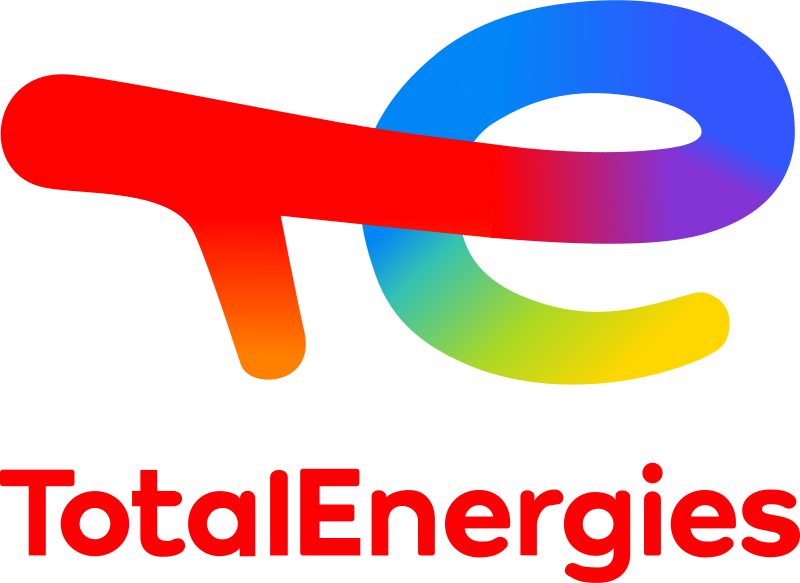The global district cooling market is poised for significant growth, driven by increasing urbanization and the rising demand for energy-efficient cooling solutions. Key growth drivers include the shift towards sustainable energy systems and stringent regulations promoting eco-friendly infrastructure. Emerging trends, such as the integration of renewable energy sources and advanced thermal storage technologies, are enhancing system efficiency and reducing environmental impact.
Opportunities abound in rapidly developing regions where infrastructural expansion is prioritizing smart city initiatives. Additionally, the growing focus on reducing carbon footprints in commercial and residential buildings presents lucrative prospects for market players, as district cooling systems offer a scalable and efficient alternative to conventional air conditioning methods. In Terms of Revenue, the Global District Cooling Market was Worth US$ 26.4 Bn in 2023, Anticipated to Witness CAGR of 8.2% During 2024 – 2034.
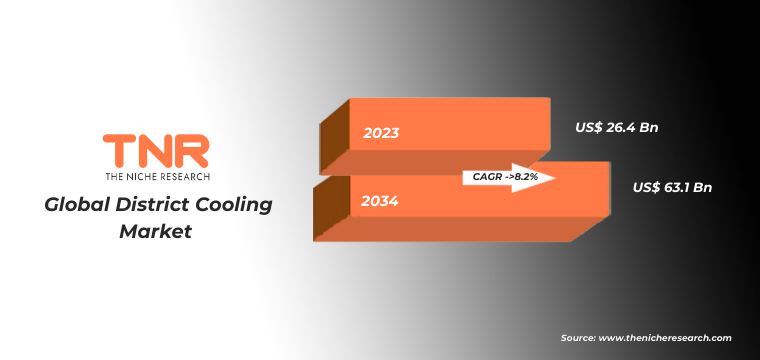
Trends in the Global District Cooling Market
- Integration of Renewable Energy Sources: The district cooling market is increasingly adopting renewable energy sources, such as solar and geothermal, to enhance sustainability. This shift is driven by global initiatives to reduce carbon emissions and reliance on fossil fuels. By integrating renewable energy, district cooling systems can operate more efficiently and sustainably, reducing operational costs and environmental impact. This trend is particularly evident in regions with abundant renewable resources, such as the Middle East, where solar energy is harnessed for large-scale cooling projects. As the demand for eco-friendly solutions grows, this integration will likely become a standard practice, further driving market expansion and innovation.
- Advancements in Thermal Energy Storage Technologies: Thermal energy storage (TES) technologies are becoming a pivotal trend in the district cooling market, enhancing the efficiency and reliability of cooling systems. By storing excess cooling energy during off-peak hours and releasing it when demand peaks, TES systems help balance energy loads, reduce operational costs, and improve system resilience. This advancement is particularly beneficial in regions with fluctuating energy demands or where grid stability is a concern. The adoption of TES is also supported by advancements in materials and design, making these systems more compact, efficient, and cost-effective. As energy efficiency becomes a critical focus, the role of TES in district cooling is expected to grow substantially.
Electric chillers by production technique category have emerged as a dominant segment in the global district cooling market, due to their superior energy efficiency and adaptability across diverse climates. These systems are favored for their ability to provide consistent and reliable cooling, particularly in large-scale commercial and residential projects. The adoption of electric chillers is further driven by advancements in chiller technology, which enhance performance while minimizing energy consumption and operational costs. Additionally, the growing emphasis on reducing carbon emissions and meeting stringent environmental regulations has bolstered the demand for electric chillers, as they offer a more sustainable alternative to traditional cooling methods reliant on fossil fuels.
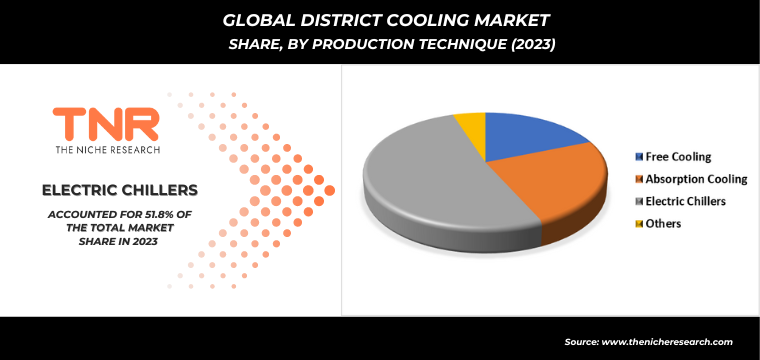
In 2023, industrial segment solidified its position as the second-largest application category within the global district cooling market, driven by the increasing demand for energy-efficient and reliable cooling solutions in manufacturing and processing facilities. As industries seek to optimize operational efficiency and reduce energy consumption, district cooling offers a scalable and cost-effective alternative to traditional cooling methods. The adoption is particularly pronounced in energy-intensive sectors like petrochemicals, pharmaceuticals, and data centers, where maintaining stable temperatures is critical. Additionally, stringent environmental regulations and the rising focus on sustainability have prompted industries to invest in district cooling systems, further bolstering this segment’s growth and market share.
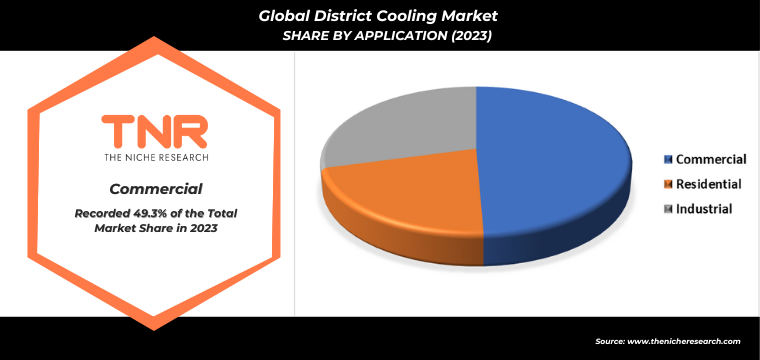
In 2023, Middle East & Africa solidified its position in the global district cooling market, contributing a revenue share of 3.8%. This growth is primarily attributed to the region’s rapidly expanding urban infrastructure and the increasing adoption of energy-efficient cooling solutions in response to extreme climatic conditions. Governments and developers in the MEA are investing heavily in district cooling systems to support large-scale projects, particularly in the Gulf Cooperation Council (GCC) countries, where sustainability is a key focus. The region’s commitment to reducing carbon footprints and enhancing energy efficiency has driven the demand for district cooling, positioning MEA as a significant player in the global market.

Competitive Landscape
Some of the players operating in the district cooling market are
- ADC Energy Systems LLC
- Alfa Laval AB
- Daikin Industries Ltd.
- Danfoss
- Emirates Central Cooling System Corporation PJSC
- Emirates District Cooling, LLC
- Engie
- Keppel Corporation Limited
- National Central Cooling Company PJSC (TABREED)
- Qatar District Cooling Company
- Shinryo Corporation
- SNC-Lavalin
- Stellar Energy
- Veolia
- Other Industry Participants
Global District Cooling Market Scope
| Report Specifications |
Details |
| Market Revenue in 2023 |
US$ 26.4 Bn |
| Market Size Forecast by 2034 |
US$ 63.1 Bn |
| Growth Rate (CAGR) |
8.2% |
| Historic Data |
2016 – 2022 |
| Base Year for Estimation |
2023 |
| Forecast Period |
2024 – 2034 |
| Report Inclusions |
Market Size & Estimates, Market Dynamics, Competitive Scenario, Trends, Growth Factors, Market Determinants, Key Investment Segmentation, Product/Service/Solutions Benchmarking |
| Segments Covered |
By Production Technique, By Application, By Region |
| Regions Covered |
North America, Europe, Asia Pacific, Middle East & Africa, Latin America |
| Countries Covered |
U.S., Canada, Mexico, Rest of North America, France, The UK, Spain, Germany, Italy, Nordic Countries (Denmark, Finland, Iceland, Sweden, Norway), Benelux Union (Belgium, The Netherlands, Luxembourg), Rest of Europe, China, Japan, India, New Zealand, Australia, South Korea, Southeast Asia (Indonesia, Thailand, Malaysia, Singapore, Rest of Southeast Asia), Rest of Asia Pacific, Saudi Arabia, UAE, Egypt, Kuwait, South Africa, Rest of Middle East & Africa, Brazil, Argentina, Rest of Latin America |
| Key Players |
ADC Energy Systems LLC, Alfa Laval AB, Daikin Industries Ltd., Danfoss, Emirates Central Cooling System Corporation PJSC, Emirates District Cooling, LLC, Engie, Keppel Corporation Limited, National Central Cooling Company PJSC (TABREED), Qatar District Cooling Company, Shinryo Corporation, SNC-Lavalin, Stellar Energy, Veolia |
| Customization Scope |
Customization allows for the inclusion/modification of content pertaining to geographical regions, countries, and specific market segments. |
| Pricing & Procurement Options |
Explore purchase options tailored to your specific research requirements |
| Contact Details |
Consult With Our Expert
Japan (Toll-Free): +81 663-386-8111
South Korea (Toll-Free): +82-808- 703-126
Saudi Arabia (Toll-Free): +966 800-850-1643
United Kingdom: +44 753-710-5080
United States: +1 302-232-5106
E-mail: askanexpert@thenicheresearch.com
|
Key Developments:
- In March 2022, Empower secured a $52.5 million contract to build a district cooling plant in Dubai, which will deliver environmentally friendly cooling services to the Dubai Land Residence Complex (DLRC) with a capacity of 23,500 refrigeration tonnes (RT). Earlier, in November 2021, Empower agreed to acquire the district cooling system of Dubai International Airport, which has a total capacity of 110,000 RT, for AED 1.1 billion. This acquisition was financed through a combination of internal funds and debt secured from both domestic and international banks with which Empower has established strategic partnerships.
- In August 2021, Empower, also known as Emirates Central Cooling Systems Corporation and one of the largest district cooling providers in the UAE, announced an agreement to acquire Nakheel’s cooling unit. Under this agreement, Empower would take over all investments related to Nakheel’s cooling systems, which serve over 18,000 customers across Dubai through 19 cooling plants.
Global District Cooling Market
By Production Technique
- Free Cooling
- Absorption Cooling
- Electric Chillers
- Others
By Application
- Commercial
- Residential
- Industrial
By Region
- North America (U.S., Canada, Mexico, Rest of North America)
- Europe (France, The UK, Spain, Germany, Italy, Nordic Countries (Denmark, Finland, Iceland, Sweden, Norway), Benelux Union (Belgium, The Netherlands, Luxembourg), Rest of Europe)
- Asia Pacific (China, Japan, India, New Zealand, Australia, South Korea, Southeast Asia (Indonesia, Thailand, Malaysia, Singapore, Rest of Southeast Asia), Rest of Asia Pacific)
- Middle East & Africa (Saudi Arabia, UAE, Egypt, Kuwait, South Africa, Rest of Middle East & Africa)
- Latin America (Brazil, Argentina, Rest of Latin America)
Report Layout:
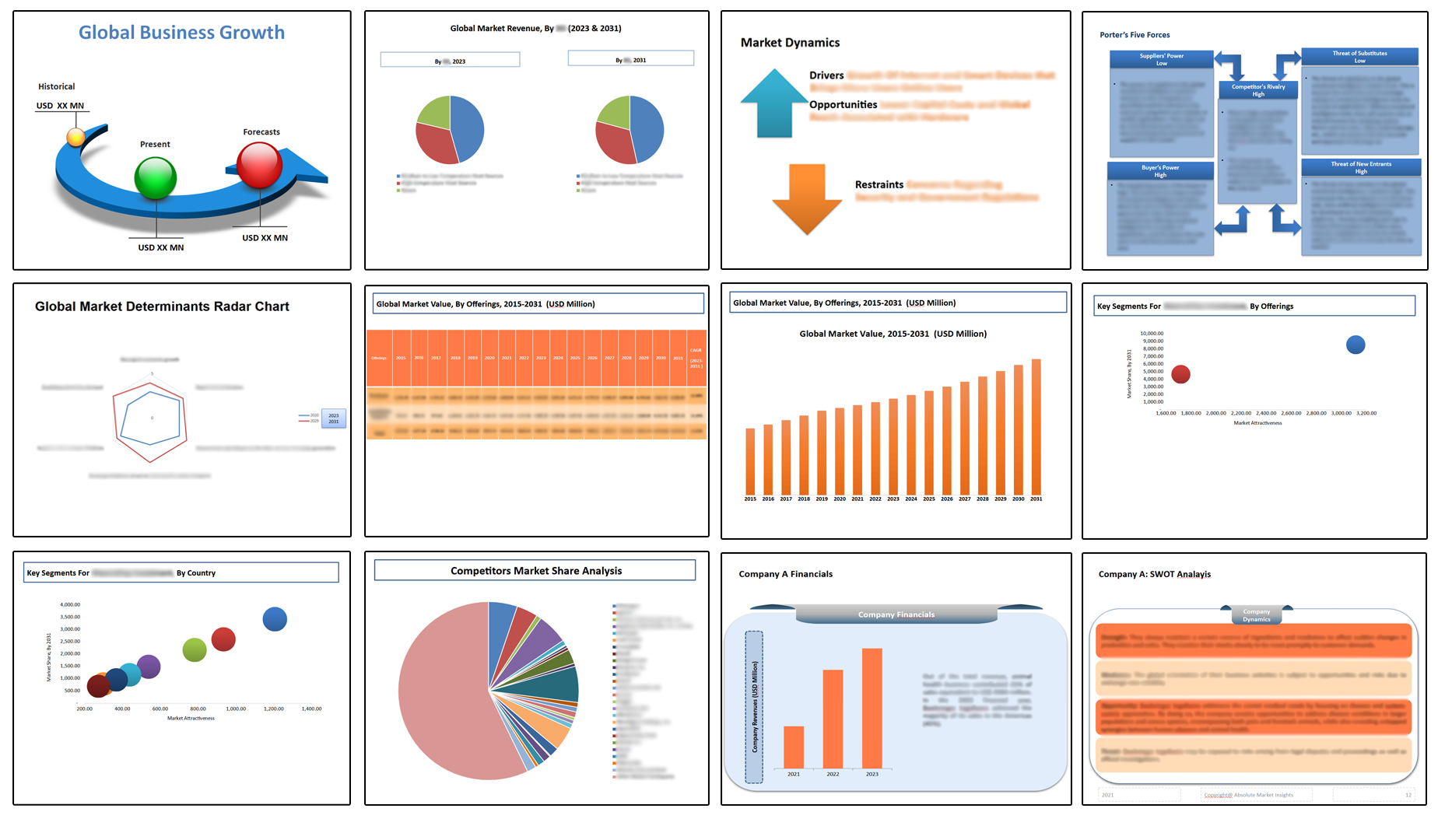
Table of Contents
.
1.Market Scope
1.2.Years Considered
1.2.1.Historic Years: 2016 – 2022
1.2.3.Forecast Years: 2024 – 2034
3.Research Methodology
3.1.Primary Research
3.1.1.Research Questionnaire
3.1.2.Global Percentage Breakdown
3.1.3.Primary Interviews: Key Opinion Leaders (KOLs)
3.3.Market Size Estimates
3.4.Data Triangulation Methodology
4.Recommendations and Insights from TNR’s Perspective**
5.Holistic Overview of District Cooling Market
6.Market Synopsis: District Cooling Market
7.District Cooling Market Analysis: Qualitative Perspective
7.1.Introduction
7.1.2.Industry Development
7.3.Trends in District Cooling Market
7.4.Market Determinants Radar Chart
7.5.Macro-Economic and Micro-Economic Indicators: District Cooling Market
7.6.Industry Gross Margin Overview
7.7.Porter’s Five Force Analysis
7.8.Impact of Covid-19 on District Cooling Market
7.10.Value Chain Analysis
7.11.Pricing Analysis, By Region (2023)
7.11.4.Middle East and Africa
8.Global District Cooling Market Analysis and Forecasts, 2024 – 2034
8.1.Overview
8.1.1.Global District Cooling Market Revenue (US$ Mn)
8.2.Global District Cooling Market Revenue (US$ Mn) and Forecasts, By Production Technique
8.2.1.Free Cooling
8.2.1.2.Market Estimation and Penetration, 2016 – 2023
8.2.1.3.Market Forecast, 2024 – 2034
8.2.1.4.Compound Annual Growth Rate (CAGR)
8.2.1.5.Regional Bifurcation
8.2.1.5.1.North America
8.2.1.5.1.1.Market Estimation, 2016 – 2023
8.2.1.5.1.2.Market Forecast, 2024 – 2034
8.2.1.5.2.Europe
8.2.1.5.2.1.Market Estimation, 2016 – 2023
8.2.1.5.2.2.Market Forecast, 2024 – 2034
8.2.1.5.3.Asia Pacific
8.2.1.5.3.1.Market Estimation, 2016 – 2023
8.2.1.5.3.2.Market Forecast, 2024 – 2034
8.2.1.5.4.Middle East and Africa
8.2.1.5.4.1.Market Estimation, 2016 – 2023
8.2.1.5.4.2.Market Forecast, 2024 – 2034
8.2.1.5.5.Latin America
8.2.1.5.5.1.Market Estimation, 2016 – 2023
8.2.1.5.5.2.Market Forecast, 2024 – 2034
8.2.2.Absorption Cooling
8.2.2.2.Market Estimation and Penetration, 2016 – 2023
8.2.2.3.Market Forecast, 2024 – 2034
8.2.2.4.Compound Annual Growth Rate (CAGR)
8.2.2.5.Regional Bifurcation
8.2.2.5.1.North America
8.2.2.5.1.1.Market Estimation, 2016 – 2023
8.2.2.5.1.2.Market Forecast, 2024 – 2034
8.2.2.5.2.Europe
8.2.2.5.2.1.Market Estimation, 2016 – 2023
8.2.2.5.2.2.Market Forecast, 2024 – 2034
8.2.2.5.3.Asia Pacific
8.2.2.5.3.1.Market Estimation, 2016 – 2023
8.2.2.5.3.2.Market Forecast, 2024 – 2034
8.2.2.5.4.Middle East and Africa
8.2.2.5.4.1.Market Estimation, 2016 – 2023
8.2.2.5.4.2.Market Forecast, 2024 – 2034
8.2.2.5.5.Latin America
8.2.2.5.5.1.Market Estimation, 2016 – 2023
8.2.2.5.5.2.Market Forecast, 2024 – 2034
8.2.3.Electric Chillers
8.2.3.2.Market Estimation and Penetration, 2016 – 2023
8.2.3.3.Market Forecast, 2024 – 2034
8.2.3.4.Compound Annual Growth Rate (CAGR)
8.2.3.5.Regional Bifurcation
8.2.3.5.1.North America
8.2.3.5.1.1.Market Estimation, 2016 – 2023
8.2.3.5.1.2.Market Forecast, 2024 – 2034
8.2.3.5.2.Europe
8.2.3.5.2.1.Market Estimation, 2016 – 2023
8.2.3.5.2.2.Market Forecast, 2024 – 2034
8.2.3.5.3.Asia Pacific
8.2.3.5.3.1.Market Estimation, 2016 – 2023
8.2.3.5.3.2.Market Forecast, 2024 – 2034
8.2.3.5.4.Middle East and Africa
8.2.3.5.4.1.Market Estimation, 2016 – 2023
8.2.3.5.4.2.Market Forecast, 2024 – 2034
8.2.3.5.5.Latin America
8.2.3.5.5.1.Market Estimation, 2016 – 2023
8.2.3.5.5.2.Market Forecast, 2024 – 2034
8.2.4.Others
8.2.4.2.Market Estimation and Penetration, 2016 – 2023
8.2.4.3.Market Forecast, 2024 – 2034
8.2.4.4.Compound Annual Growth Rate (CAGR)
8.2.4.5.Regional Bifurcation
8.2.4.5.1.North America
8.2.4.5.1.1.Market Estimation, 2016 – 2023
8.2.4.5.1.2.Market Forecast, 2024 – 2034
8.2.4.5.2.Europe
8.2.4.5.2.1.Market Estimation, 2016 – 2023
8.2.4.5.2.2.Market Forecast, 2024 – 2034
8.2.4.5.3.Asia Pacific
8.2.4.5.3.1.Market Estimation, 2016 – 2023
8.2.4.5.3.2.Market Forecast, 2024 – 2034
8.2.4.5.4.Middle East and Africa
8.2.4.5.4.1.Market Estimation, 2016 – 2023
8.2.4.5.4.2.Market Forecast, 2024 – 2034
8.2.4.5.5.Latin America
8.2.4.5.5.1.Market Estimation, 2016 – 2023
8.2.4.5.5.2.Market Forecast, 2024 – 2034
8.3.Key Segment for Channeling Investments
8.3.1.By Production Technique
9.Global District Cooling Market Analysis and Forecasts, 2024 – 2034
9.2.Global District Cooling Market Revenue (US$ Mn) and Forecasts, By Application
9.2.1.Commercial
9.2.1.2.Market Estimation and Penetration, 2016 – 2023
9.2.1.3.Market Forecast, 2024 – 2034
9.2.1.4.Compound Annual Growth Rate (CAGR)
9.2.1.5.Regional Bifurcation
9.2.1.5.1.North America
9.2.1.5.1.1.Market Estimation, 2016 – 2023
9.2.1.5.1.2.Market Forecast, 2024 – 2034
9.2.1.5.2.Europe
9.2.1.5.2.1.Market Estimation, 2016 – 2023
9.2.1.5.2.2.Market Forecast, 2024 – 2034
9.2.1.5.3.Asia Pacific
9.2.1.5.3.1.Market Estimation, 2016 – 2023
9.2.1.5.3.2.Market Forecast, 2024 – 2034
9.2.1.5.4.Middle East and Africa
9.2.1.5.4.1.Market Estimation, 2016 – 2023
9.2.1.5.4.2.Market Forecast, 2024 – 2034
9.2.1.5.5.Latin America
9.2.1.5.5.1.Market Estimation, 2016 – 2023
9.2.1.5.5.2.Market Forecast, 2024 – 2034
9.2.2.Residential
9.2.2.2.Market Estimation and Penetration, 2016 – 2023
9.2.2.3.Market Forecast, 2024 – 2034
9.2.2.4.Compound Annual Growth Rate (CAGR)
9.2.2.5.Regional Bifurcation
9.2.2.5.1.North America
9.2.2.5.1.1.Market Estimation, 2016 – 2023
9.2.2.5.1.2.Market Forecast, 2024 – 2034
9.2.2.5.2.Europe
9.2.2.5.2.1.Market Estimation, 2016 – 2023
9.2.2.5.2.2.Market Forecast, 2024 – 2034
9.2.2.5.3.Asia Pacific
9.2.2.5.3.1.Market Estimation, 2016 – 2023
9.2.2.5.3.2.Market Forecast, 2024 – 2034
9.2.2.5.4.Middle East and Africa
9.2.2.5.4.1.Market Estimation, 2016 – 2023
9.2.2.5.4.2.Market Forecast, 2024 – 2034
9.2.2.5.5.Latin America
9.2.2.5.5.1.Market Estimation, 2016 – 2023
9.2.2.5.5.2.Market Forecast, 2024 – 2034
9.2.3.Industrial
9.2.3.2.Market Estimation and Penetration, 2016 – 2023
9.2.3.3.Market Forecast, 2024 – 2034
9.2.3.4.Compound Annual Growth Rate (CAGR)
9.2.3.5.Regional Bifurcation
9.2.3.5.1.North America
9.2.3.5.1.1.Market Estimation, 2016 – 2023
9.2.3.5.1.2.Market Forecast, 2024 – 2034
9.2.3.5.2.Europe
9.2.3.5.2.1.Market Estimation, 2016 – 2023
9.2.3.5.2.2.Market Forecast, 2024 – 2034
9.2.3.5.3.Asia Pacific
9.2.3.5.3.1.Market Estimation, 2016 – 2023
9.2.3.5.3.2.Market Forecast, 2024 – 2034
9.2.3.5.4.Middle East and Africa
9.2.3.5.4.1.Market Estimation, 2016 – 2023
9.2.3.5.4.2.Market Forecast, 2024 – 2034
9.2.3.5.5.Latin America
9.2.3.5.5.1.Market Estimation, 2016 – 2023
9.2.3.5.5.2.Market Forecast, 2024 – 2034
9.3.Key Segment for Channeling Investments
10.North America District Cooling Market Analysis and Forecasts, 2024 – 2034
10.1.Overview
10.1.1.North America District Cooling Market Revenue (US$ Mn)
10.2.North America District Cooling Market Revenue (US$ Mn) and Forecasts, By Production Technique
10.2.2.Absorption Cooling
10.3.North America District Cooling Market Revenue (US$ Mn) and Forecasts, By Application
10.4.North America District Cooling Market Revenue (US$ Mn) and Forecasts, By Country
10.4.1.U.S
10.4.1.1.U.S District Cooling Market Revenue (US$ Mn) and Forecasts, By Production Technique
10.4.1.1.2.Absorption Cooling
10.4.1.1.3.Electric Chillers
10.4.1.2.U.S District Cooling Market Revenue (US$ Mn) and Forecasts, By Application
10.4.2.Canada
10.4.2.1.Canada District Cooling Market Revenue (US$ Mn) and Forecasts, By Production Technique
10.4.2.1.2.Absorption Cooling
10.4.2.1.3.Electric Chillers
10.4.2.2.Canada District Cooling Market Revenue (US$ Mn) and Forecasts, By Application
10.4.3.Mexico
10.4.3.1.Mexico District Cooling Market Revenue (US$ Mn) and Forecasts, By Production Technique
10.4.3.1.2.Absorption Cooling
10.4.3.1.3.Electric Chillers
10.4.3.2.Mexico District Cooling Market Revenue (US$ Mn) and Forecasts, By Application
10.4.4.Rest of North America
10.4.4.1.Rest of North America District Cooling Market Revenue (US$ Mn) and Forecasts, By Production Technique
10.4.4.1.2.Absorption Cooling
10.4.4.1.3.Electric Chillers
10.4.4.2.Rest of North America District Cooling Market Revenue (US$ Mn) and Forecasts, By Application
10.5.Key Segment for Channeling Investments
10.5.2.By Production Technique
11.Europe District Cooling Market Analysis and Forecasts, 2024 – 2034
11.1.Overview
11.1.1.Europe District Cooling Market Revenue (US$ Mn)
11.2.Europe District Cooling Market Revenue (US$ Mn) and Forecasts, By Production Technique
11.2.2.Absorption Cooling
11.3.Europe District Cooling Market Revenue (US$ Mn) and Forecasts, By Application
11.4.Europe District Cooling Market Revenue (US$ Mn) and Forecasts, By Country
11.4.1.France
11.4.1.1.France District Cooling Market Revenue (US$ Mn) and Forecasts, By Production Technique
11.4.1.1.2.Absorption Cooling
11.4.1.1.3.Electric Chillers
11.4.1.2.France District Cooling Market Revenue (US$ Mn) and Forecasts, By Application
11.4.2.The UK
11.4.2.1.The UK District Cooling Market Revenue (US$ Mn) and Forecasts, By Production Technique
11.4.2.1.2.Absorption Cooling
11.4.2.1.3.Electric Chillers
11.4.2.2.The UK District Cooling Market Revenue (US$ Mn) and Forecasts, By Application
11.4.3.Spain
11.4.3.1.Spain District Cooling Market Revenue (US$ Mn) and Forecasts, By Production Technique
11.4.3.1.2.Absorption Cooling
11.4.3.1.3.Electric Chillers
11.4.3.2.Spain District Cooling Market Revenue (US$ Mn) and Forecasts, By Application
11.4.4.Germany
11.4.4.1.Germany District Cooling Market Revenue (US$ Mn) and Forecasts, By Production Technique
11.4.4.1.2.Absorption Cooling
11.4.4.1.3.Electric Chillers
11.4.4.2.Germany District Cooling Market Revenue (US$ Mn) and Forecasts, By Application
11.4.5.Italy
11.4.5.1.Italy District Cooling Market Revenue (US$ Mn) and Forecasts, By Production Technique
11.4.5.1.2.Absorption Cooling
11.4.5.1.3.Electric Chillers
11.4.5.2.Italy District Cooling Market Revenue (US$ Mn) and Forecasts, By Application
11.4.6.Nordic Countries
11.4.6.1.Nordic Countries District Cooling Market Revenue (US$ Mn) and Forecasts, By Production Technique
11.4.6.1.2.Absorption Cooling
11.4.6.1.3.Electric Chillers
11.4.6.2.Nordic Countries District Cooling Market Revenue (US$ Mn) and Forecasts, By Application
11.4.6.3.Nordic Countries District Cooling Market Revenue (US$ Mn) and Forecasts, By Country
11.4.7.Benelux Union
11.4.7.1.Benelux Union District Cooling Market Revenue (US$ Mn) and Forecasts, By Production Technique
11.4.7.1.2.Absorption Cooling
11.4.7.1.3.Electric Chillers
11.4.7.2.Benelux Union District Cooling Market Revenue (US$ Mn) and Forecasts, By Application
11.4.7.3.Benelux Union District Cooling Market Revenue (US$ Mn) and Forecasts, By Country
11.4.7.3.2.The Netherlands
11.4.8.Rest of Europe
11.4.8.1.Rest of Europe District Cooling Market Revenue (US$ Mn) and Forecasts, By Production Technique
11.4.8.1.2.Absorption Cooling
11.4.8.1.3.Electric Chillers
11.4.8.2.Rest of Europe District Cooling Market Revenue (US$ Mn) and Forecasts, By Application
11.5.Key Segment for Channeling Investments
11.5.2.By Production Technique
12.Asia Pacific District Cooling Market Analysis and Forecasts, 2024 – 2034
12.1.Overview
12.1.1.Asia Pacific District Cooling Market Revenue (US$ Mn)
12.2.Asia Pacific District Cooling Market Revenue (US$ Mn) and Forecasts, By Production Technique
12.2.2.Absorption Cooling
12.3.Asia Pacific District Cooling Market Revenue (US$ Mn) and Forecasts, By Application
12.4.Asia Pacific District Cooling Market Revenue (US$ Mn) and Forecasts, By Country
12.4.1.China
12.4.1.1.China District Cooling Market Revenue (US$ Mn) and Forecasts, By Production Technique
12.4.1.1.2.Absorption Cooling
12.4.1.1.3.Electric Chillers
12.4.1.2.China District Cooling Market Revenue (US$ Mn) and Forecasts, By Application
12.4.2.Japan
12.4.2.1.Japan District Cooling Market Revenue (US$ Mn) and Forecasts, By Production Technique
12.4.2.1.2.Absorption Cooling
12.4.2.1.3.Electric Chillers
12.4.2.2.Japan District Cooling Market Revenue (US$ Mn) and Forecasts, By Application
12.4.3.India
12.4.3.1.India District Cooling Market Revenue (US$ Mn) and Forecasts, By Production Technique
12.4.3.1.2.Absorption Cooling
12.4.3.1.3.Electric Chillers
12.4.3.2.India District Cooling Market Revenue (US$ Mn) and Forecasts, By Application
12.4.4.New Zealand
12.4.4.1.New Zealand District Cooling Market Revenue (US$ Mn) and Forecasts, By Production Technique
12.4.4.1.2.Absorption Cooling
12.4.4.1.3.Electric Chillers
12.4.4.2.New Zealand District Cooling Market Revenue (US$ Mn) and Forecasts, By Application
12.4.5.Australia
12.4.5.1.Australia District Cooling Market Revenue (US$ Mn) and Forecasts, By Production Technique
12.4.5.1.2.Absorption Cooling
12.4.5.1.3.Electric Chillers
12.4.5.2.Australia District Cooling Market Revenue (US$ Mn) and Forecasts, By Application
12.4.6.South Korea
12.4.6.1.South Korea District Cooling Market Revenue (US$ Mn) and Forecasts, By Production Technique
12.4.6.1.2.Absorption Cooling
12.4.6.1.3.Electric Chillers
12.4.6.2.South Korea District Cooling Market Revenue (US$ Mn) and Forecasts, By Application
12.4.7.Southeast Asia
12.4.7.1.Southeast Asia District Cooling Market Revenue (US$ Mn) and Forecasts, By Production Technique
12.4.7.1.2.Absorption Cooling
12.4.7.1.3.Electric Chillers
12.4.7.2.Southeast Asia District Cooling Market Revenue (US$ Mn) and Forecasts, By Application
12.4.7.3.Southeast Asia District Cooling Market Revenue (US$ Mn) and Forecasts, By Country
12.4.7.3.5.Rest of Southeast Asia
12.4.8.Rest of Asia Pacific
12.4.8.1.Rest of Asia Pacific District Cooling Market Revenue (US$ Mn) and Forecasts, By Production Technique
12.4.8.1.2.Absorption Cooling
12.4.8.1.3.Electric Chillers
12.4.8.2.Rest of Asia Pacific District Cooling Market Revenue (US$ Mn) and Forecasts, By Application
12.5.Key Segment for Channeling Investments
12.5.2.By Production Technique
13.Middle East and Africa District Cooling Market Analysis and Forecasts, 2024 – 2034
13.1.Overview
13.1.1.Middle East and Africa District Cooling Market Revenue (US$ Mn)
13.2.Middle East and Africa District Cooling Market Revenue (US$ Mn) and Forecasts, By Production Technique
13.2.2.Absorption Cooling
13.3.Middle East and Africa District Cooling Market Revenue (US$ Mn) and Forecasts, By Application
13.4.Middle East and Africa District Cooling Market Revenue (US$ Mn) and Forecasts, By Country
13.4.1.Saudi Arabia
13.4.1.1.Saudi Arabia District Cooling Market Revenue (US$ Mn) and Forecasts, By Production Technique
13.4.1.1.2.Absorption Cooling
13.4.1.1.3.Electric Chillers
13.4.1.2.Saudi Arabia District Cooling Market Revenue (US$ Mn) and Forecasts, By Application
13.4.2.UAE
13.4.2.1.UAE District Cooling Market Revenue (US$ Mn) and Forecasts, By Production Technique
13.4.2.1.2.Absorption Cooling
13.4.2.1.3.Electric Chillers
13.4.2.2.UAE District Cooling Market Revenue (US$ Mn) and Forecasts, By Application
13.4.3.Egypt
13.4.3.1.Egypt District Cooling Market Revenue (US$ Mn) and Forecasts, By Production Technique
13.4.3.1.2.Absorption Cooling
13.4.3.1.3.Electric Chillers
13.4.3.2.Egypt District Cooling Market Revenue (US$ Mn) and Forecasts, By Application
13.4.4.Kuwait
13.4.4.1.Kuwait District Cooling Market Revenue (US$ Mn) and Forecasts, By Production Technique
13.4.4.1.2.Absorption Cooling
13.4.4.1.3.Electric Chillers
13.4.4.2.Kuwait District Cooling Market Revenue (US$ Mn) and Forecasts, By Application
13.4.5.South Africa
13.4.5.1.South Africa District Cooling Market Revenue (US$ Mn) and Forecasts, By Production Technique
13.4.5.1.2.Absorption Cooling
13.4.5.1.3.Electric Chillers
13.4.5.2.South Africa District Cooling Market Revenue (US$ Mn) and Forecasts, By Application
13.4.6.Rest of Middle East & Africa
13.4.6.1.Rest of Middle East & Africa District Cooling Market Revenue (US$ Mn) and Forecasts, By Production Technique
13.4.6.1.2.Absorption Cooling
13.4.6.1.3.Electric Chillers
13.4.6.2.Rest of Middle East & Africa District Cooling Market Revenue (US$ Mn) and Forecasts, By Application
13.5.Key Segment for Channeling Investments
13.5.2.By Production Technique
14.Latin America District Cooling Market Analysis and Forecasts, 2024 – 2034
14.1.Overview
14.1.1.Latin America District Cooling Market Revenue (US$ Mn)
14.2.Latin America District Cooling Market Revenue (US$ Mn) and Forecasts, By Production Technique
14.2.2.Absorption Cooling
14.3.Latin America District Cooling Market Revenue (US$ Mn) and Forecasts, By Application
14.4.Latin America District Cooling Market Revenue (US$ Mn) and Forecasts, By Country
14.4.1.Brazil
14.4.1.1.Brazil District Cooling Market Revenue (US$ Mn) and Forecasts, By Production Technique
14.4.1.1.2.Absorption Cooling
14.4.1.1.3.Electric Chillers
14.4.1.2.Brazil District Cooling Market Revenue (US$ Mn) and Forecasts, By Application
14.4.2.Argentina
14.4.2.1.Argentina District Cooling Market Revenue (US$ Mn) and Forecasts, By Production Technique
14.4.2.1.2.Absorption Cooling
14.4.2.1.3.Electric Chillers
14.4.2.2.Argentina District Cooling Market Revenue (US$ Mn) and Forecasts, By Application
14.4.3.Rest of Latin America
14.4.3.1.Rest of Latin America District Cooling Market Revenue (US$ Mn) and Forecasts, By Production Technique
14.4.3.1.2.Absorption Cooling
14.4.3.1.3.Electric Chillers
14.4.3.2.Rest of Latin America District Cooling Market Revenue (US$ Mn) and Forecasts, By Application
14.5.Key Segment for Channeling Investments
14.5.2.By Production Technique
15.Competitive Benchmarking
15.2.Market Share Analysis, 2023
15.3.Global Presence and Growth Strategies
15.3.1.Mergers and Acquisitions
15.3.3.Investments Trends
16.Player Profiles
16.1.ADC Energy Systems LLC
16.1.5.Financial Analysis
16.1.7.Business Strategies
16.2.Alfa Laval AB
16.2.5.Financial Analysis
16.2.7.Business Strategies
16.3.Daikin Industries Ltd.
16.3.5.Financial Analysis
16.3.7.Business Strategies
16.4.Danfoss
16.4.5.Financial Analysis
16.4.7.Business Strategies
16.5.Emirates Central Cooling System Corporation PJSC
16.5.5.Financial Analysis
16.5.7.Business Strategies
16.6.Emirates District Cooling, LLC
16.6.5.Financial Analysis
16.6.7.Business Strategies
16.7.Engie
16.7.5.Financial Analysis
16.7.7.Business Strategies
16.8.Keppel Corporation Limited
16.8.5.Financial Analysis
16.8.7.Business Strategies
16.9.National Central Cooling Company PJSC (TABREED)
16.9.5.Financial Analysis
16.9.7.Business Strategies
16.10.Qatar District Cooling Company
16.10.3.Product Offerings
16.10.5.Financial Analysis
16.10.7.Business Strategies
16.11.Shinryo Corporation
16.11.3.Product Offerings
16.11.5.Financial Analysis
16.11.7.Business Strategies
16.12.SNC-Lavalin
16.12.3.Product Offerings
16.12.5.Financial Analysis
16.12.7.Business Strategies
16.13.Stellar Energy
16.13.3.Product Offerings
16.13.5.Financial Analysis
16.13.7.Business Strategies
16.14.Veolia
16.14.3.Product Offerings
16.14.5.Financial Analysis
16.14.7.Business Strategies
16.15.Other Industry Participants
.
Note: This ToC is tentative and can be changed according to the research study conducted during the course of report completion.
.
**Exclusive for Multi-User and Enterprise User.
Global District Cooling Market
By Production Technique
- Free Cooling
- Absorption Cooling
- Electric Chillers
- Others
By Application
- Commercial
- Residential
- Industrial
By Region
- North America (U.S., Canada, Mexico, Rest of North America)
- Europe (France, The UK, Spain, Germany, Italy, Nordic Countries (Denmark, Finland, Iceland, Sweden, Norway), Benelux Union (Belgium, The Netherlands, Luxembourg), Rest of Europe)
- Asia Pacific (China, Japan, India, New Zealand, Australia, South Korea, Southeast Asia (Indonesia, Thailand, Malaysia, Singapore, Rest of Southeast Asia), Rest of Asia Pacific)
- Middle East & Africa (Saudi Arabia, UAE, Egypt, Kuwait, South Africa, Rest of Middle East & Africa)
- Latin America (Brazil, Argentina, Rest of Latin America)
The Niche Research approach encompasses both primary and secondary research methods to provide comprehensive insights. While primary research is the cornerstone of our studies, we also incorporate secondary research sources such as company annual reports, premium industry databases, press releases, industry journals, and white papers.
Within our primary research, we actively engage with various industry stakeholders, conducting paid interviews and surveys. Our meticulous analysis extends to every market participant in major countries, allowing us to thoroughly examine their portfolios, calculate market shares, and segment revenues.
Our data collection primarily focuses on individual countries within our research scope, enabling us to estimate regional market sizes. Typically, we employ a bottom-up approach, meticulously tracking trends in different countries. We analyze growth drivers, constraints, technological innovations, and opportunities for each country, ultimately arriving at regional figures.Our process begins by examining the growth prospects of each country. Building upon these insights, we project growth and trends for the entire region. Finally, we utilize our proprietary model to refine estimations and forecasts.
Our data validation standards are integral to ensuring the reliability and accuracy of our research findings. Here’s a breakdown of our data validation processes and the stakeholders we engage with during our primary research:
- Supply Side Analysis: We initiate a supply side analysis by directly contacting market participants, through telephonic interviews and questionnaires containing both open-ended and close-ended questions. We gather information on their portfolios, segment revenues, developments, and growth strategies.
- Demand Side Analysis: To gain insights into adoption trends and consumer preferences, we reach out to target customers and users (non-vendors). This information forms a vital part of the qualitative analysis section of our reports, covering market dynamics, adoption trends, consumer behavior, spending patterns, and other related aspects.
- Consultant Insights: We tap into the expertise of our partner consultants from around the world to obtain their unique viewpoints and perspectives. Their insights contribute to a well-rounded understanding of the markets under investigation.
- In-House Validation: To ensure data accuracy and reliability, we conduct cross-validation of data points and information through our in-house team of consultants and utilize advanced data modeling tools for thorough verification.
The forecasts we provide are based on a comprehensive assessment of various factors, including:
- Market Trends and Past Performance (Last Five Years): We accurately analyze market trends and performance data from preceding five years to identify historical patterns and understand the market’s evolution.
- Historical Performance and Growth of Market Participants: We assess the historical performance and growth trajectories of key market participants. This analysis provides insights into the competitive landscape and individual company strategies.
- Market Determinants Impact Analysis (Next Eight Years): We conduct a rigorous analysis of the factors that are projected to influence the market over the next eight years. This includes assessing both internal and external determinants that can shape market dynamics.
- Drivers and Challenges for the Forecast Period:Identify the factors expected to drive market growth during the forecast period, as well as the challenges that the industry may face. This analysis aids in deriving an accurate growth rate projection.
- New Acquisitions, Collaborations, or Partnerships: We keep a close watch on any new acquisitions, collaborations, or partnerships within the industry. These developments can have a significant impact on market dynamics and competitiveness.
- Macro and Micro Factors Analysis:A thorough examination of both macro-level factors (e.g., economic trends, regulatory changes) and micro-level factors (e.g., technological advancements, consumer preferences) that may influence the market during the forecast period.
- End-User Sentiment Analysis: To understand the market from the end-user perspective, we conduct sentiment analysis. This involves assessing the sentiment, preferences, and feedback of the end-users, which can provide valuable insights into market trends.
- Perspective of Primary Participants: Insights gathered directly from primary research participants play a crucial role in shaping our forecasts. Their perspectives and experiences provide valuable qualitative data.
- Year-on-Year Growth Trend: We utilize a year-on-year growth trend based on historical market growth and expected future trends. This helps in formulating our growth projections, aligning them with the market’s historical performance.
Research process adopted by TNR involves multiple stages, including data collection, validation, quality checks, and presentation. It’s crucial that the data and information we provide add value to your existing market understanding and expertise. We have also established partnerships with business consulting, research, and survey organizations across regions and globally to collaborate on regional analysis and data validation, ensuring the highest level of accuracy and reliability in our reports.














